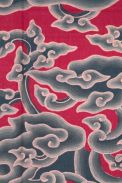Exhibition of batik megamendung
From 20 september to 6 october 2013 - 10.00 am 18.00 pm
The batik of Cirebon
In order to know the batik, a typical object of Cirebon area, is important to know some fundamental information about the historical, geographical and cultural contest where this manufacture has been created during the centuries.
Cirebon city is located on the north-west cost of Java Island, which is situated in the central area of the Indonesian archipelago.
Geographically, Cirebon belongs to the ethnic and cultural area of Pesisir. Actually, the city has had, during the centuries, an important role as the location of Kraton (royal palaces). For this reason it hasn’t been actively involved in the vibrant and commercial life of the other city- centers of the coast. It has obtained, on the other hand, a cultural and social role, which is comparable to the cities of the central area of Java, locations of important princely courts.
During the centuries, the city has had a fundamental role in the identification of the batik variety which were created in Java city.
The batik which was produced in Cirebon city have a typical iconography. They were also the most important ones of Java’s production. Some of these artifacts were addressed to the important and royal courts of S and Y.
Cirebon people converted to the Islam religion before the others cities did.
Unlike Mataram, Cirebon wasn’t compelled to the conversion by the Islamic military forces, but fascinated by the development and the pacific diffusion of the Islamic arts and culture in the whole area.
The culture of the city, however, was hardly influenced by the indu and the chinese culture. In particular, the latter arose at the end of the eighteenth and during the whole nineteenth century, after the settlement of the Chinese groups, although their Islamic culture.
Most of the animal figures which were used as decorations of the Cirebon’s batik have Hindu origins. During the eras, the batik has changed its aspect in order to respect the indications of the Islamic law.
Observing the introduction of geometrical and arabesque paintings, we become aware of the clear influence of Islam on the iconographical heritage used in the city for the decoration of the typical batik.
Generally speaking, the typical batik of Cirebon is characterized by well highlight and quite bold paintings, without frills and little descriptive details.
The most typical decorations of batik of this area are:
“wadasan” (rock)
“megamendung” (cloud)
that denotes the taste and the stylistic sensitivity that derives from China.
Even the palette used in order to paint this drawings has clear Chinese origins. The most-used color, and the one which dominates the paintings, is blue (and its gradations), whereas the background was painted with another color. The most typical are: white (used for porcelains), red, orange-ochre and pastel green.
But that’s not all: the influence of Chinese culture and esthetics is also visible in the introduction of floral motifs and, above all, animals (in particular: the lion-dog and the phoenix),which are typical of that culture.
Sometimes, when Kraton and the court required batik for prestigious occasions, artists added also elephant pictures and the ones of the dragon.
Written by Bruno Gentili
Translation by Martina Maffioli
Bibliography:
- Pepin van Roojen - "Batik Design" -
The Pepin Press Amsterdam/Singapore
- Inger McCabe Elliott - "Batik Flabet of Java" -
Periplus Ed. Singapore
